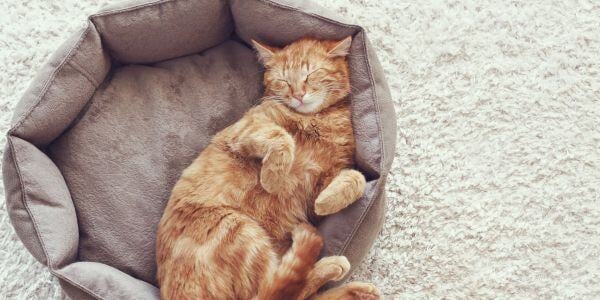 Cats are different from humans in many ways, but one way in which we are similar is that we can’t escape getting older.
Cats are different from humans in many ways, but one way in which we are similar is that we can’t escape getting older.
While we may be prepared for our kitties to be less active and to have medical issues as they age, many of us may not be prepared for our cats to develop behavior changes related to cognitive decline. These changes are actually quite common in cats.
Cognitive Dysfunction Syndrome (CDS), which is the official name for feline dementia, develops gradually and becomes worse slowly over time.
There is no known exact cause of feline cognitive dysfunction, but it is similar, but not identical, to Alzheimer’s disease in humans.
28% of 11-14-year-old cats and 50% of cats 15+ years of age show signs of CDS.
Current research points to oxidative damage, chronic inflammation, and reduced blood flow to the brain. Many cats also have other medical issues that overlap with their CDS, which can play an important role in the behavior signs of CDS. In fact, treatment of these medical issues can greatly reduce the CDS signs. Read on to see how you can help your kitty with this medical condition.
Skip to section:
What Are the Signs of Cognitive Dysfunction in Cats?
Increased Meowing or Yowling
Your cat may vocalize at odd times, like the middle of the night or when you’re out of the room. They may seem disoriented or confused while this is happening. Read more about the causes of excessive meowing and yowling in cats.
Changes in Interactions with Family and Other Pets
You may notice your cat suddenly becoming very clingy, needing your attention, and feeling anxious when separated from you. On the other hand, you could see your cat withdrawing. They may spend more time tucked away in their safe spots, less interested in affection or attention.

Sleep Cycle Interruptions
Cats may suddenly become active at night and sleep during the day. Or sleep may be disrupted through the night.
Changes in Litter Box Habit
Previously litter-trained cats may start peeing and/or pooping outside their litter box.
Changes in Activity Level
Changes, either an increased activity level or a decreased activity level.
Anxiety
Your cat may seem anxious. This is shown by changes in their normal behavior, such as feeling less comfortable and secure as they move through the home, less active or receptive to play and affection, more reactive or aggressive to other pets or people, etc.
Issues with Learning and Memory
Some examples might include:
-
A cat who doesn’t seem to know how to exit an area, like a corner or hiding spot.
-
A cat who begs to be fed not long after being fed.
-
A cat who forgets where their favorite bed is or wanders around vocal as if they’re searching for something.
-
A cat who seems to forget where you are when they’ve just seen you.
If you notice any of these signs in your cat, it is time for a veterinary visit. Take a video, if possible, of any unusual behaviors. Videos are very helpful for your veterinarian since most cats behave very differently in the veterinary clinic than they do at home.
Also, keeping a log of any incidents and a video record of your cat’s changes over time can show if the signs are stable or progressing.

It’s important to note there are other reasons your cat may show some of these signs. Vocalizing can happen due to physical discomfort, hearing critters in the walls, or stranger cats outside. Being less active can be a sign of pain or stress.
Anxiety can come on due to a host of different stressors unrelated to cognitive health. These are just a few examples. So, don’t panic if your senior starts showing the signs above. Just get to your vet so they can do a thorough exam and think about any changes to their environment or schedule, and any potential triggers that may have come up around the time you noticed changes.
How a Veterinarian Diagnoses Cognitive Decline in Cats
Since there is no specific test for Cognitive Dysfunction Syndrome, your vet will diagnose CDS by ruling out any other medical or behavioral issues. Your vet will take a thorough history, perform a physical exam, and do lab tests to determine the cause of your cat’s symptoms.
Many of the medical issues that a senior cat faces can cause a change in behavior. Treatment of the disease also helps reduce or eliminate the associated behaviors. Also, early diagnosis and treatment of issues such as hyperthyroidism, diabetes, and chronic kidney disease lead to a much longer survival and better quality of life.
Here is a list of the problems your vet will need to rule out before diagnosing Cognitive Dysfunction Syndrome:
Pain: In older cats, the most common painful areas are joints from arthritis and teeth from dental disease. Pain in any body area could contribute to behavior changes. Cats exhibit pain differently than dogs.
High Blood Pressure: This condition can cause headaches, confusion, anxiety, and vision changes in people. In cats, we know that high blood pressure can cause behavior changes and even blindness due to retinal detachment.
Hyperthyroidism (overactive thyroid): Cats with hyperthyroidism can have a variety of behavior changes due to their increased metabolic rate and hunger. Increased meowing, getting into food, diarrhea, house soiling, restlessness, irritability, and change in their interactions with family members are all possible.
Diabetes Mellitus and Chronic Kidney Disease: These diseases can cause a cat to drink more and urinate in large amounts. These cats are also more prone to urinary tract infections. As a result, these cats may fill up a litter box quickly and stop using it if it becomes too dirty for them. Or they may just not make it to the box at all if the urge to urinate is too strong.
Additionally, some diabetic cats have increased hunger. They may seek more attention or beg for food because they are hungry.
Hearing or Vision Loss: Cats with hearing and/or vision loss are likely to be disoriented and have behavior changes. This is also common in people, who have a much higher risk of dementia and Alzheimer’s with vision and hearing loss.
Liver Failure: When the liver fails, a cat can develop a condition called hepatic encephalopathy, in which the toxins that the liver could not clear start to affect the brain. An affected cat may be dull, tired, disoriented, wobbly walking, and having signs that are worse after eating. Some cats may develop seizures. Cats may also have signs of liver disease, such as vomiting, diarrhea, distended abdomen, drooling, increased urination, and increased drinking.
Infection or Cancer: These are very broad categories of systemic (whole-body) diseases that can cause pain and changes in how a cat interacts with their family and their environment.
Behavioral Issues: If the changes in behavior can be attributed to conditions such as separation anxiety, fear, or defensive aggression, then they can be addressed.

How to Help Your Cat with Cognitive Decline
Behavioral Enrichment
Giving your cat ways to exercise their mind and body can help slow down the progression of this and other conditions. It also supports emotional health, which we know is an important part of any medical treatment.
Whether you’re looking at play or mental enrichment ideas, keep your cat’s limitations in mind. You may need to adjust play sessions to be less active, focusing on smaller spaces and moving more slowly. Enrichment may need to be simplified. You can learn about ways to meet your senior cat’s needs while respecting their limitations in our article, Enrichment And Activity for Senior Cats.
Diet
Because cats with CDS have evidence of oxidative damage in their brains, focus on diets with higher levels of antioxidants and fish oils for older cats to prevent and treat CDS.
Over-the-counter diets with fish oils, and antioxidants to help longevity and brain function:
-
Purina Pro Plan Prime Plus – Chicken and Rice Dry Food
- Purina Pro Plan Prime Plux – Wet Food Variety Pack
Prescription kidney diet + mobility diet (antioxidants & chondroitin):
A study of a similar diet showed improvement in CDS signs in 70% of cats.
Prescription diets with alpha-casozepine to help with anxiety:
-
Royal Canin Calm (dry)
-
Hill’s c/d Multicare Stress in chicken, tuna, or ocean fish flavors (designed for cats with lower urinary tract disease)
Supplements
For anxiety:
-
Zylkene contains alpha-casozepine, the same ingredient as the last two diets listed above. Although it comes as a capsule, this is a milk-based protein powder, so you can easily open the capsule and mix it with wet food or a paste treat (like Churu).
-
Anxitane is a chewable treat containing L-Theanine, which helps reduce cat stress signs.
If you feel the anxiety your cat is experiencing from cognitive decline is impacting their quality of life, talk with your vet about whether a prescription anti-anxiety medication could be helpful.
For cognitive signs:
S-Adenosyl-l-Methionine (SAMe) is an antioxidant compound normally made in the body. In a study of cats with CDS, cats who received SAMe had improved cognitive tests, especially if it was given early in the course of the disease. Nutramax makes this supplement called Denosyl.

For sleep:
Melatonin: Cats who cannot sleep at night may benefit from melatonin. Discuss with your veterinarian whether melatonin would help your cat, and make sure your vet knows all of your cat’s medications so that there are no interactions. Make sure the melatonin doesn't contain xylitol, an ingredient that is HIGHLY TOXIC to dogs and cats. Learn more about the dangers of xylitol.
Prescription Medication
For cognitive signs:
Selegiline (Anipryl) is an FDA-approved medication for dogs with cognitive dysfunction syndrome (CDS). It is sometimes used off-label in cats. It is not a cure, and it is partially helpful in some cases. Selegiline has many severe drug interactions, including fluoxetine (Prozac), clomipramine, and amitriptyline. It can take up to 6 weeks to see improvement in CDS signs.
Your veterinarian may recommend additional prescription medications such as fluoxetine for anxiety, gabapentin for pain, or a sedative to help your cat rest at night.
Follow-Up Veterinary Care and Prognosis
Your vet will likely want to see your cat every 3–6 months. Between visits, keep a log of how your cat is doing.
Here are examples of logs that cat parents have brought to me:
-
Daily dairy of “events” such as how much their cat eats, bathroom habits, sleeping, movements, etc.
-
Paper calendar with major incidents marked. These include house-soiling events, an episode of getting agitated, or events like an especially good day.
-
My patient’s Instagram page!
All these logs work well because they show trends over time. You should use what works best for you.
Cognitive Dysfunction Syndrome progresses slowly over time. Each cat’s progression is different. Don’t become discouraged. Although there is no cure for feline dementia, most cats can live comfortably with environmental enrichment and medical management.




